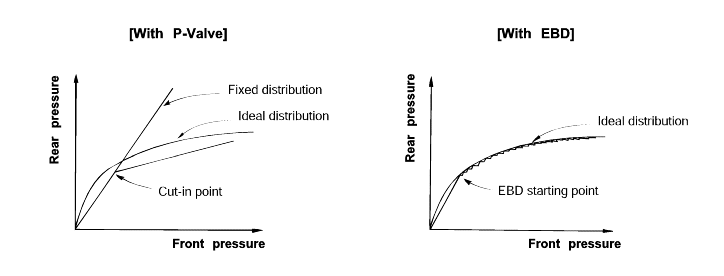
NORMAL BRAKING
Solenoid valve | State | Valve | Passage |
IN (NO) | OFF | OPEN | Master cylinder ⇔ Wheel cylinder |
OUT (NC) | OFF | CLOSE | Wheel cylinder ⇔ Reservoir |
DUMP MODE
Solenoid valve | State | Valve | Passage |
IN (NO) | ON | CLOSE | Master cylinder ⇔ Wheel cylinder |
OUT (NC) | ON | OPEN | Wheel cylinder ⇔ Reservoir |
HOLD MODE
Solenoid valve | State | Valve | Passage |
IN (NO) | ON | CLOSE | Master cylinder ⇔ Wheel cylinder |
OUT (NC) | OFF | CLOSE | Wheel cylinder ⇔ Reservoir |
INCREASE MODE
Solenoid valve | State | Valve | Passage |
IN (NO) | OFF | OPEN | Master cylinder ⇔ Wheel cylinder |
OUT (NC) | OFF | CLOSE | Wheel cylinder ⇔ Reservoir |
NORMAL MODE
Solenoid valve | State | Valve | Motor pump | TC valve |
IN (NO) | OFF | OPEN | OFF | OFF |
OUT (NC) | OFF | CLOSE |
● In the normal driving condition, TC valve (normally open) is the passage between the master cylinder and the each wheel cylinder. ● When brake pedal is applied, brake pressure is delivered to the wheel cylinders via NO-TC valve and all solenoid valves inside the hydraulic unitare deactivated. ● In case of TCS malfunction it does not affect brake operation. |
PRESSURE INCREASE MODE
Solenoid valve | State | Valve | Motor pump | TC valve |
IN (NO) | FRONT : OFF REAR : ON | FRONT : OPEN REAR : CLOSE | ON | ON |
OUT (NC) | OFF | CLOSE |
● If a front wheel spin is detected, TCS begins a brake control to decrease a wheel spin. ● Hydraulic shuttle valve (HSV) is opened. Brake fluid is supplied from the master cylinder by motor operation to the spin wheel via HSV. ● TC valve is closed (ON). Brake pressure generated from motor pump is delivered only to the front wheel. ● Inlet valve remains open to deliver the brake pressure generated from motor pump to the spinning wheels. |
PRESSURE DUMP MODE
Solenoid valve | State | Valve | Motor pump | TC valve |
IN (NO) | ON | CLOSE | ON | ON |
OUT (NC) | FRONT : ON REAR : OFF | FRONT : OPEN REAR : CLOSE |
● When the wheel deceleration is under the threshold and the wheel spin is reduced under a slip threshold, applied brake pressure is reduced to geta optimum traction force. ● Outlet valve is open to release the brake pressure and inlet valve is closed to block the pressure increase from the motor pump. ● Hydraulic shuttle valve (HSV) remains opened, TC valve is ON. ● Motor is ON, to dump the brake fluid being released from the lock-up wheel. |
PRESSURE HOLD MODE
Solenoid valve | State | Valve | Motor pump | TC valve |
IN (NO) | ON | CLOSE | ON | ON |
OUT (NC) | OFF | CLOSE |
Function improvement of the base-brake system.
Compensation for the different friction coefficients.
Elimination of the proportioning valve.
Failure recognition by the warning lamp.

FAIL CAUSE | SYSTEM | WARNING LAMP | ||
ABS | EBD | ABS | EBD | |
None | ON | ON | OFF | OFF |
1-Wheel speed sensor failure | OFF | ON | ON | OFF |
Pump malfunction | OFF | ON | ON | OFF |
Low voltage | OFF | ON | ON | OFF |
2 or more wheel speed sensor failure | OFF | OFF | ON | ON |
Solenoid valve failure | ||||
HECU malfunction | ||||
Other failure | ||||

ABS warning lamp module
The active ABS warning lamp module indicates the operating condition of the ABS.
The ABS warning lamp is turned on under the following conditions.
During the initialization phase after ignition switch ON (3 seconds).
In the event of inhibition of ABS functions by failure.
When the system ECU is shut down even though ignition power is applied.
During diagnostic mode.
EBD warning lamp module
The active EBD warning lamp module indicates the operating condition of the EBD. However, in case the parking brake switch is turned on, the EBDwarning lamp is always turned on regardless of EBD functions.
The EBD warning lamp is turned on under the following conditions.
During the initialization phase after ignition switch ON. (3 seconds).
When the system ECU is shut down even though ignition power is applied.
When the parking brake switch is ON or brake fluid is low level.
TCS lamp module
The passive TCS warning lamp module indicates the operating condition of the TCS.
The TCS warning lamp is turned on under the following conditions :
During the initialization phase after ignition switch ON (3 seconds).
In the event of inhibition of TCS functions by failure.
When the TCS OFF switch is turned on.
TCS function lamp is turned on when the TCS functions are operating (Blinking-2Hz).